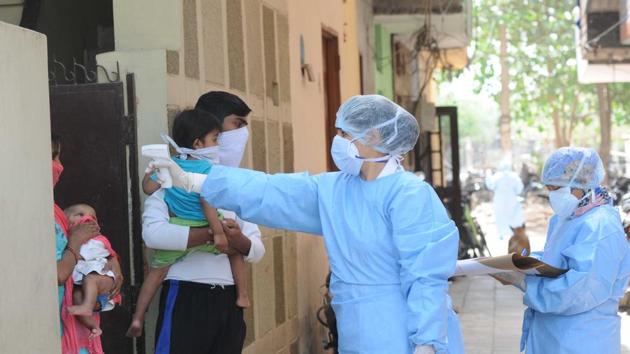Only 19% of active cases in hot spots
According to the data, of the city’s 11 revenue districts, Shahdara has the highest share of patients living inside containment zones (32.8%, or nearly one out of every three), followed by New Delhi district (23.5%) and West district (22.1%).
Less than one out of every five (18.6%) active cases of the coronanvirus disease (Covid-19) in Delhi were located inside the city’s 1,670-odd containment zones as on September 16, according to unreleased government data accessed by HT -- data that experts said could be grounds for overhauling the containment strategy in the Capital.

According to the data, of the city’s 11 revenue districts, Shahdara has the highest share of patients living inside containment zones (32.8%, or nearly one out of every three), followed by New Delhi district (23.5%) and West district (22.1%).
The data was part of a report that was submitted by the revenue department to the office of the Delhi chief secretary Vijay Dev ahead of the Delhi Disaster Management Authority (DDMA) meeting on Friday, chaired by lieutenant governor Anil Baijal in which directions were issued to redraft Delhi’s containment strategy.
The report said, as on September 16, of the city’s 31,201 active cases, only 5,800 were located inside 1,670 containment zones, while the others were located outside hot spots. Experts said this shows that a majority of Delhi’s active infections are scattered outside containment zones, suggesting that the city needs to strengthen locality-based surveillance and contact tracing.
By Sunday evening, of the total 246,711 cases in Delhi, 32,097 were active, and the containment zones had increased to 1,872, according to the government’s health bulletin. The city added 3,812 new infections and 37 new deaths on Sunday.
In absolute numbers, of the active cases inside containment zones till Wednesday, south-west Delhi had the most (815), followed by the northwest (769) and west districts (774). South-west and west districts also have the highest number of containment zones – 325 and 223 respectively.
These three districts have a mix of planned neighbourhoods – such as Dwarka in south-west and Rohini in north-west – and a large number of unauthorised colonies, with scattered slum clusters. The New Delhi district is largely constituted by blocks of central government quarters and few unauthorised colonies and slums.
“We are keeping a close eye on trends and doing our best to create containment zones wherever we spot clusters and the potential threat of the spread of Covid-19. Usually, three cases located within close proximity qualifies an area for assessment as a containment zone. The rule, however, is flexible. If there is adequate space, all individual cases can be allotted home isolation. But that is not possible in congested areas with high population density. Currently, as cases have witnessed a spike again, we have scaled up both testing and containment strategies,” said Neha Bansal, district magistrate (west).
District magistrate (southwest) Rahul Singh said, “We have created containment zones under guidelines issued by the Union government. Each area has been assessed before surveillance was scaled up. The idea is to break the chain of transmission.”
Delhi’s revenue minister Kailash Gahlot said, “At this juncture, the government is aggressively creating containment zones in order to break the chain of transmission at the earliest. However, it is important to mention that the focus of the government is on creating smaller containment zones so that fewer people are affected. The status of the containment zones is periodically reviewed.”
Based on the same dataset, HT reported on Saturday highlighting how Delhi’s active cases were spread unevenly through the Capital. Delhi’s north-west district accounted for 16.3% of the total number of active cases (31,201) – the highest among the city’s 11 districts. The same district, however, has 15.1% of its active cases in containment zones – a lower proportion than eight revenue districts.
Interestingly, Shahdara had only 1,813 active Covid-19 cases – the lowest in terms of share out of the total 31,201. But one-third of the identified Covid-19 cases were in containment zones.
“This data shows that a larger proportion of Covid-19 cases in Delhi are scattered and isolated, or non-cluster, in nature. So, it is high time that the government comes up with a better plan to strengthen locality-based surveillance, depending on caseload from area to area, and improve contact tracing. In ideal circumstances, all Covid-19 cases should be isolated – either in residences of patients or hospitals and quarantine centres – but the government should think of doing away with containment zones at this juncture,” said Dr Jugal Kishore, head of community medicines at Safdarjung Hospital and vice-president of the Indian Association of Epidemiologists.
Dr Lalit Kant, head of the division of epidemiology & communicable diseases at the Indian Council of Medical Research (ICMR), said, “Once a containment zone is identified, its residents are screened and tested in a systematic way, which does not happen in general areas. So, containment zones will always have a certain chunk of the active cases. But further analysis would be difficult unless we learn about the complete testing strategy inside and outside containment zones and analyse the data over a period of time.”






